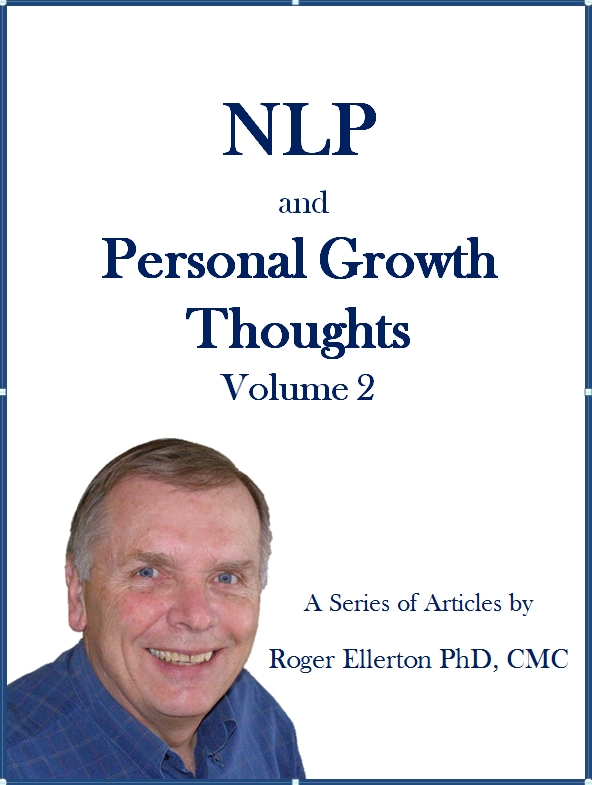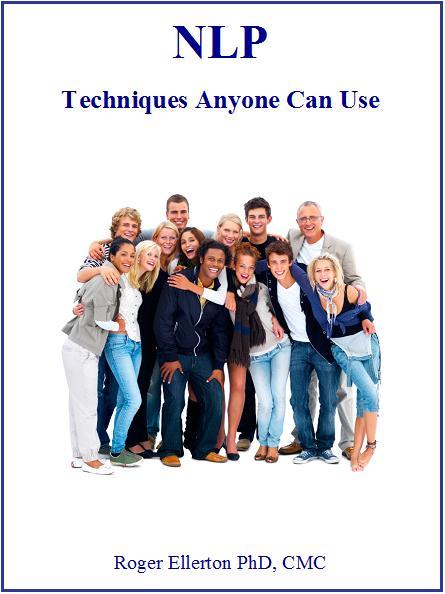Milton Model
By Roger Ellerton Phd, ISP, CMC, Renewal Technologies Inc.
This article may not be republished without written permission from Roger Ellerton/Renewal Technologies Inc. If you republish this article without permission, you will be in violation of copyright law and sent an invoice. You may share this and other pages with your friends by linking directly to this page from your website or blog.
The Meta Model assists a client to be more specific or precise about his problem and as a result he begins to discover possible resources or solutions to his problem. Gregory Bateson was enthusiastic about this approach and he was also aware of the work of Milton Erickson who was also getting great results with his clients, but in a different way - being vague rather than specific, the exact opposite of the Meta Model. Bateson encouraged John Grinder and Richard Bandler to meet Erickson and discover why he was so successful. Their description of Erickson's methods became known as the Milton Model - an approach opposite to the Meta Model, yet an equally useful tool for personal change and human communication.
"The Milton Model is a way of using language to induce and maintain trance in order to contact hidden resources of our personality. It follows the way the mind works naturally. Trance is a state where you are highly motivated to learn from your unconscious mind in an inner directed way. It is not a passive state, nor are you under another's influence. There is co-operation between client and therapist, the client's responses letting the therapist know what to do next."(pp. 113-114)
Introducing NLP Psychological Skills for Understanding and Influencing People Neuro-Linguistic Programming, Joseph O'Connor and John Seymour.
Milton Erickson
Milton Erickson was generally regarded as the foremost hypnotherapist of his time. He worked with trance and cleverly structured sentences full of vague meanings to help his clients discover how to address their problems and the resources that they already had available to them. Erickson's success was based on his ability to read non-verbal behaviour (sensory acuity), his ability to establish rapport with his clients, his skill with language patterns and his beliefs about his clients - some of his beliefs appear in the list of NLP Presuppositions. For example:
- Every behaviour has a positive intention.
- This is the best choice available to a person given the circumstances as they see it.
- Respect for the other person's model of the world.
- Resistance in a client is due to a lack of rapport. That is there are no resistant clients, only inflexible therapists.
Erickson would also pace a client's experience and then begin to lead them into trance (or downtime). In NLP terms, uptime is when your senses are focused on the outside world, while downtime is related to your inner thoughts. The Meta Model is associated with uptime (i.e. who, what, how specifically), while the Milton Model is associated with downtime. As we go through our daily activities, we are continually cycling through uptime and downtime and are often somewhere in between.
Pacing and Leading
To pace a client, begin by matching and mirroring her physiology, choice of words, tone of voice, etc., then make reference to what she would most likely be seeing, hearing, feeling or thinking (e.g. "As you notice the lights slowly dimming ... ." or "As you hear my voice ... ." or "As you feel the chair on your back ... ." or "As you wonder ... .") while speaking slowly in a soft tonally and pacing your speech to her breathing. To lead her into downtime, you would begin to focus her attention inward by saying something such as "You may notice how easy it is to close your eyes whenever you wish to feel more relaxed ... ."
The topic of trance and hypnosis is vast. The rest of this article will focus on the Milton Model, which is a set of language patterns used to:
- Pace and lead.
- Distract the conscious mind.
- Speak directly to the unconscious and access its hidden resources.
For more information on hypnosis, the Milton Model and other hypnotic techniques, please see Hypnosis: A Comprehensive Guide by Tad James.
Milton Model: Hypnotic Language Patterns
The Milton Model hypnotic language patterns encourage the listener to move away from detail and content and move to higher levels of thinking and deeper states of mind. Some patterns are used to establish a trance state (or downtime or relaxation in the body). Other patterns are used to loosen the listener's model of the world from which he is expressing his current behaviours and to consider a more expansive interpretation of what is possible.
You will notice that many of these language patterns are identical to those of the Meta Model. The difference being that for the Meta Model, the client is being vague and we ask specific questions to assist him in getting clarity on his issue/problem. For the Milton Model, we use some of the same language patterns, but this time we wish to be vague so that the client can easily go into trance and/or from the vague suggestions choose a suggested course of action that will address his problem/issue.
- Mind Read: Claiming to know another's thoughts or feelings without specifying the how you came to that knowledge.
"I know that you believe ..." or "I know you're thinking ..."
- Lost Performative: Expressing value judgments without identifying the one doing the judging.
"Breathing is good."
- Cause & Effect: Implies one thing leads to or causes another; that there is sequence of cause/effect and a flow in time. Includes phrases such as: "If ..., then ...; As you ...., then you ...; Because ... then ..."
"If you can hear my voice, then you can learn many things."
- Complex Equivalence: Attributes meaning to something that may or may not have a 'cause' capability.
"Being here means that you will change easily."
- Presupposition: The linguistic equivalent of assumptions.
"Will you be changing your attitude now or later today?" It is assumed the person will change their attitude, the only unknown is when.
- Universal Quantifier: Universal generalizations without referential index.
"Everyone; No one; All; Every"
- Modal Operator: Words that refer to possibility or necessity or that reflect internal states of intensity tied to our rules in life.
"You should care for others." or "You must resolve this issue."
- Nominalization: Words which are formed as nouns and which are shorthand for processes.
"People can come to new understandings." Here 'understandings' is used as a noun and is shorthand to describe the on-going experience of 'understanding' or 'making sense of something'.
- Unspecified Verb: Implies action without describing how the action has/will take place.
"He caused the problem."
- Tag Question: A question added at the end of a statement/question, designed to soften resistance. It is used to ratify to the listener that he has or will actually manifest the action. It has the structure of a question and often the tonality of a statement.
"Your perception of life is changing, isn't it."
- Lack of Referential Index: An expression without specific reference to any portion of the speakers/listeners experience.
"People can change."
- Comparative Deletion (Unspecified Comparison): A comparison is made without specific reference to what or to whom it is being compared.
"You will enjoy it more." or "That one is better."
- Pace Current Experience: Using sensory-grounded, behaviorally specific information to describe current experience.
"You are reading this article."
- Double Bind: Invites choice within a larger context of 'no choice'.
"Do you want to begin now or later?" or "Do you want to go into trance before or after you sit down?"
- Embedded Commands: This is a command that forms part of a larger sentence that is marked by using italics or a subtle change in voice tonality or body language and is picked up by the reader's or listener's unconscious.
"I will not suggest to you that change is easy." or "Do you think this article should be sent to your friends?" or "You can learn this material easily."
- Conversational Postulate: Are questions that operate at multiple levels. Although they require only a simple yes or no answer, they invite you to engage in an activity in some way. Often they contain an embedded command.
"Can you open the door?" or "Can you choose to change?"
- Extended Quote: Is a rambling context for the delivery of information that may be in the format of a command.
"Many years ago, I remember meeting a wise old man who taught me many useful things. I cherished all of his advice. I remember one particular day when he said to me "Change is easy and can be fun"."
- Selectional Restriction Violation: Attributing intelligence or animation to inanimate objects.
"Your chair can support you as you make these changes." or "Your diary tells interesting tales."
- Ambiguity: Lack of specificity
a. Phonological: "your" and "you're" - same sound, different meaning.
b. Syntactic: More than one possible meaning. "shooting stars" or "leadership shows" - the syntax is uncertain within the context, i.e. adjectives, verbs or nouns?
c. Scope: "Speaking to you as a changed person ..." (Who is the changed person?) or "The old men and women ..." - the context does not reveal the scope to which a verb or modifier applies.
d. Punctuation: is unexpected and does not 'follow the rules', i.e. improper pauses, rambling sentences, incomplete sentences - all of which ultimately force the listener to 'mind read'.
"Hand me your watch how quickly you go into a trance." - Utilization: Takes advantage of everything in the listeners experience (both internal and external environments) to support the intention of the speaker.
Client says: "I don't understand." Response: "That's right...you don't understand, yet, because you've not taken that one deep breath that will allow the information to fall easily and comfortably into place."
Or perhaps while working with a client, one of your colleagues mistakenly opens a door. Instead of getting frustrated and annoyed with your colleague, you could say to your client, "You may have heard a door opening and let this be an opportunity to invite new ideas and thoughts into your life."
And NLP is Much more than that!
Author: Roger Ellerton is a certified NLP trainer, certified management consultant and the founder and managing partner of Renewal Technologies. The above article is based on his book Live Your Dreams Let Reality Catch Up: NLP and Common Sense for Coaches, Managers and You.
Copyright © 2005, Renewal Technologies Inc. All rights reserved.








